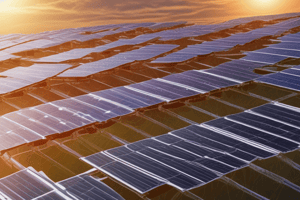Podcast
Questions and Answers
Which type of PV cell is known for having the highest efficiency typically ranging from 15% to 22%?
Which type of PV cell is known for having the highest efficiency typically ranging from 15% to 22%?
- Monocrystalline Silicon PV Cells (correct)
- Perovskite PV Cells
- Thin-Film PV Cells
- Polycrystalline Silicon PV Cells
What is a key characteristic of Polycrystalline Silicon PV Cells?
What is a key characteristic of Polycrystalline Silicon PV Cells?
- They are made from single-crystal silicon.
- They exhibit a distinctive blue color. (correct)
- They are the most space-efficient PV cells.
- They require the most complex manufacturing process.
Which type of Thin-Film PV cell has an efficiency range of typically around 9% to 12%?
Which type of Thin-Film PV cell has an efficiency range of typically around 9% to 12%?
- Perovskite
- Amorphous Silicon (a-Si)
- Cadmium Telluride (CdTe) (correct)
- Copper Indium Gallium Selenide (CIGS)
What is a significant advantage of Perovskite PV cells compared to other PV technologies?
What is a significant advantage of Perovskite PV cells compared to other PV technologies?
Which type of PV cell typically requires the least space for electricity generation?
Which type of PV cell typically requires the least space for electricity generation?
What is one disadvantage of Thin-Film PV Cells compared to crystalline silicon cells?
What is one disadvantage of Thin-Film PV Cells compared to crystalline silicon cells?
What efficiency range is typical for Amorphous Silicon (a-Si) Thin-Film PV Cells?
What efficiency range is typical for Amorphous Silicon (a-Si) Thin-Film PV Cells?
Which characteristic is NOT associated with Monocrystalline Silicon PV Cells?
Which characteristic is NOT associated with Monocrystalline Silicon PV Cells?
Which type of control technique integrates past errors to eliminate steady-state errors?
Which type of control technique integrates past errors to eliminate steady-state errors?
What is the primary benefit of implementing Adaptive Control in converter systems?
What is the primary benefit of implementing Adaptive Control in converter systems?
Which control method is designed to ensure robustness against disturbances by adhering to a sliding surface?
Which control method is designed to ensure robustness against disturbances by adhering to a sliding surface?
What is a key consideration when optimizing converter operation for energy efficiency?
What is a key consideration when optimizing converter operation for energy efficiency?
Which of the following best describes Model Predictive Control (MPC)?
Which of the following best describes Model Predictive Control (MPC)?
Fault detection in converters primarily aims to identify which of the following conditions?
Fault detection in converters primarily aims to identify which of the following conditions?
What role does Digital Signal Processing (DSP) play in converter management?
What role does Digital Signal Processing (DSP) play in converter management?
How can communication interfaces contribute to the effectiveness of power converters?
How can communication interfaces contribute to the effectiveness of power converters?
What is the primary function of a combiner box in a PV array?
What is the primary function of a combiner box in a PV array?
Which type of inverter is designed for systems where there is no access to the utility grid?
Which type of inverter is designed for systems where there is no access to the utility grid?
What is the purpose of Maximum Power Point Tracking (MPPT) in inverters?
What is the purpose of Maximum Power Point Tracking (MPPT) in inverters?
Which of the following is NOT a design consideration for PV arrays?
Which of the following is NOT a design consideration for PV arrays?
What role do charge controllers play in solar systems?
What role do charge controllers play in solar systems?
What is the main benefit of connecting PV modules in series?
What is the main benefit of connecting PV modules in series?
In terms of wiring, what is a critical consideration for connecting PV modules and combiner boxes?
In terms of wiring, what is a critical consideration for connecting PV modules and combiner boxes?
What type of DC-DC converter is used to lower voltage from the PV array?
What type of DC-DC converter is used to lower voltage from the PV array?
Which application typically uses larger PV arrays installed on buildings or ground-mounted?
Which application typically uses larger PV arrays installed on buildings or ground-mounted?
Which statement describes a feature of PWM charge controllers?
Which statement describes a feature of PWM charge controllers?
What is one purpose of the mounting structure in a PV array?
What is one purpose of the mounting structure in a PV array?
What is the primary role of power electronic converters in solar energy systems?
What is the primary role of power electronic converters in solar energy systems?
What is a key factor in defining the number of modules to connect in series within a PV array?
What is a key factor in defining the number of modules to connect in series within a PV array?
Which is NOT a common type of inverter used in solar systems?
Which is NOT a common type of inverter used in solar systems?
What is Open Circuit Voltage (Voc) in a PV cell?
What is Open Circuit Voltage (Voc) in a PV cell?
How does the Short Circuit Current (Isc) behave with varying sunlight intensity?
How does the Short Circuit Current (Isc) behave with varying sunlight intensity?
Which statement describes the behavior of the Maximum Power Point (MPP) in a PV cell?
Which statement describes the behavior of the Maximum Power Point (MPP) in a PV cell?
What is the effect of temperature on Open Circuit Voltage (Voc)?
What is the effect of temperature on Open Circuit Voltage (Voc)?
What do MPPT algorithms accomplish in PV systems?
What do MPPT algorithms accomplish in PV systems?
What might represent non-ideal effects in a PV model?
What might represent non-ideal effects in a PV model?
Which type of PV model is the simplest and most commonly utilized?
Which type of PV model is the simplest and most commonly utilized?
Which characteristic describes the I-V curve of a PV cell?
Which characteristic describes the I-V curve of a PV cell?
Which of the following is true regarding temperature coefficients in PV models?
Which of the following is true regarding temperature coefficients in PV models?
What defines a PV array?
What defines a PV array?
How do thin-film solar cells compare to monocrystalline and polycrystalline cells?
How do thin-film solar cells compare to monocrystalline and polycrystalline cells?
What effect does decreased carrier mobility have on Short Circuit Current (Isc)?
What effect does decreased carrier mobility have on Short Circuit Current (Isc)?
What do PV models use to predict power output?
What do PV models use to predict power output?
What happens to Maximum Power Point (MPP) under varying environmental conditions?
What happens to Maximum Power Point (MPP) under varying environmental conditions?
What is the primary purpose of Maximum Power Point Tracking (MPPT) algorithms?
What is the primary purpose of Maximum Power Point Tracking (MPPT) algorithms?
Which of the following is a disadvantage of the Perturb and Observe (P&O) algorithm?
Which of the following is a disadvantage of the Perturb and Observe (P&O) algorithm?
What advantage does the Incremental Conductance algorithm have over the P&O method?
What advantage does the Incremental Conductance algorithm have over the P&O method?
What is a characteristic of Model-Based MPPT algorithms?
What is a characteristic of Model-Based MPPT algorithms?
Which aspect is NOT a control objective of converter control in solar systems?
Which aspect is NOT a control objective of converter control in solar systems?
In the context of MPPT algorithms, what does 'dynamic response' refer to?
In the context of MPPT algorithms, what does 'dynamic response' refer to?
Heuristic and Hybrid MPPT algorithms generally aim to achieve what?
Heuristic and Hybrid MPPT algorithms generally aim to achieve what?
What is a key disadvantage of Model-Based MPPT algorithms?
What is a key disadvantage of Model-Based MPPT algorithms?
What is involved in power flow management within solar converter control?
What is involved in power flow management within solar converter control?
A potential drawback of using heuristic and hybrid MPPT algorithms is:
A potential drawback of using heuristic and hybrid MPPT algorithms is:
Why is voltage regulation critical in converter control for grid-tied systems?
Why is voltage regulation critical in converter control for grid-tied systems?
What factor affects the choice of MPPT algorithm in solar energy systems?
What factor affects the choice of MPPT algorithm in solar energy systems?
Which of the following is crucial for minimizing power losses in solar energy systems?
Which of the following is crucial for minimizing power losses in solar energy systems?
Flashcards are hidden until you start studying
Study Notes
Photovoltaic (PV) Cells
- PV cells convert sunlight directly into electricity.
- Monocrystalline silicon cells are the most efficient type, offering high efficiency (15%-22%) and durability.
- Polycrystalline silicon cells are less efficient (13%-18%) but cheaper due to simpler production processes.
- Thin-film PV cells are made by depositing layers of photovoltaic material onto a substrate.
- Amorphous silicon (a-Si) is flexible and easy to manufacture, but with lower efficiency (6%-10%).
- Cadmium Telluride (CdTe) provides higher efficiency (9%-12%) and competitive cost.
- Copper Indium Gallium Selenide (CIGS) offers high efficiency potential (10%-13%) and better performance in low-light conditions.
- Perovskite PV cells are a newer technology with rapidly improving efficiency, surpassing 25% in some cases. They are potentially cost-effective and flexible.
V-I Characteristics of a PV Cell
- V-I characteristics describe how a PV cell's electrical output varies.
- Open Circuit Voltage (Voc) is the voltage across the cell when no current flows. It decreases slightly with increasing temperature and varies linearly with sunlight intensity.
- Short Circuit Current (Isc) is the current flowing when the voltage is zero. It increases linearly with sunlight intensity and decreases with increasing temperature due to reduced carrier mobility.
- Maximum Power Point (MPP) is the operating point where the product of voltage and current is maximized, resulting in maximum power output.
PV Model
- A PV model represents the electrical behavior of a PV cell or module through equations and parameters.
- It includes parameters like Isc, Voc, Imp, and Vmp, which are temperature-dependent.
- Non-ideal effects like shunt resistance (Rsh) and series resistance (Rs) are considered.
- Different PV models exist, including Single Diode Model, Double Diode Model, and Empirical Models.
PV Array
- A PV array is a collection of interconnected PV modules.
- Components include PV modules, support structure, interconnection wiring, combiner box, and inverters (for grid-tied systems).
- Series connection increases array voltage, while parallel connection increases array current.
- Design considerations include electrical characteristics, system voltage, array configuration, and maintenance.
Power Electronic Converters for Solar Systems
- Converters manage the flow and conversion of electrical power between DC and AC.
- Inverters convert DC power from PV arrays to AC power, enabling use in appliances and grid connection.
- Grid-tied inverters synchronize with the utility grid.
- Off-grid inverters provide standalone operation.
- Hybrid inverters combine features of grid-tied and off-grid.
- Charge controllers regulate battery charging and discharging in off-grid systems.
- PWM (Pulse Width Modulation) charge controllers use rapid on/off switches.
- MPPT (Maximum Power Point Tracking) charge controllers optimize power transfer.
- DC-DC converters adjust voltage levels between components for efficiency and compatibility.
- Boost converters increase voltage.
- Buck converters decrease voltage.
- Buck-boost converters can step up or down voltage.
Maximum Power Point Tracking (MPPT) Algorithms
- MPPT algorithms dynamically adjust the PV array's operating point to maximize power output under varying conditions.
- Perturb and Observe (P&O) algorithm perturbs the voltage/current and observes power output changes.
- Incremental Conductance algorithm utilizes the change in conductance (dP/dV or dP/dI) to determine MPP.
- Model-based MPPT algorithms use mathematical models of the PV array to predict and calculate MPP.
- Heuristic and Hybrid algorithms combine elements of different techniques for robustness.
Converter Control
- Converter control ensures stable and efficient operation of power electronic converters.
- Control objectives include:
- Voltage and Current Regulation
- Maximum Power Point Tracking (MPPT)
- Stability and protection
- Control techniques include:
- Feedback control loops
- Adaptive control algorithms
- Predictive control strategies
Power Flow Management
- Ensures efficient utilization of generated power by managing the flow between the PV array, batteries, and the load or grid
- Optimizes energy storage if batteries are integrated
Fault Detection and Protection
- Quickly detects faults, such as over-voltage, under-voltage, over-current, and over-temperature conditions
- Implements protective measures to isolate or shut down the converter preventing damage and ensuring safety
Control Techniques
Proportional-Integral (PI) Control
- Commonly used for voltage and current regulation in power converters
- The proportional term adjusts the control action based on the error, while the integral term integrates past errors to eliminate steady-state errors
Advanced Control Algorithms
- Predictive Control: Uses a system model to predict future behavior and optimize control actions
- Model Predictive Control (MPC): Utilizes an explicit model of the converter and system constraints to calculate optimal control inputs
- Sliding Mode Control: Ensures robustness to parameter variations and disturbances by forcing the system trajectory to follow a sliding surface
Adaptive Control
- Dynamically adjusts controller parameters based on changing system conditions
- Enhances performance and stability over a wide range of conditions
Digital Signal Processing (DSP)
- Utilizes digital control techniques for implementing complex control algorithms
- Delivers high precision and flexibility enabling real-time monitoring, analysis, and operation adjustment
Implementation Considerations
- System Dynamics: Accounts for the dynamic behavior of PV arrays, load variations, and environmental changes such as solar irradiance fluctuations
- Communication Interfaces: Interacts with communication protocols like Modbus or CAN bus for system monitoring, data logging, and remote control
- Efficiency and Reliability: Optimizes converter operation for maximum energy efficiency and reliable performance over the system's lifetime
- Safety and Compliance: Adheres to safety standards and regulations for grid-tied inverters, ensuring compliance with grid codes and specifications
Studying That Suits You
Use AI to generate personalized quizzes and flashcards to suit your learning preferences.





